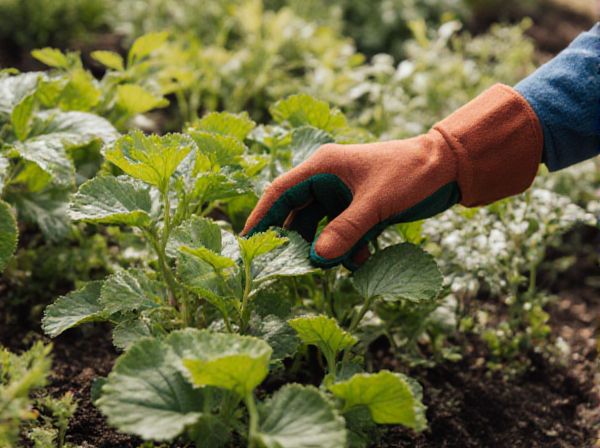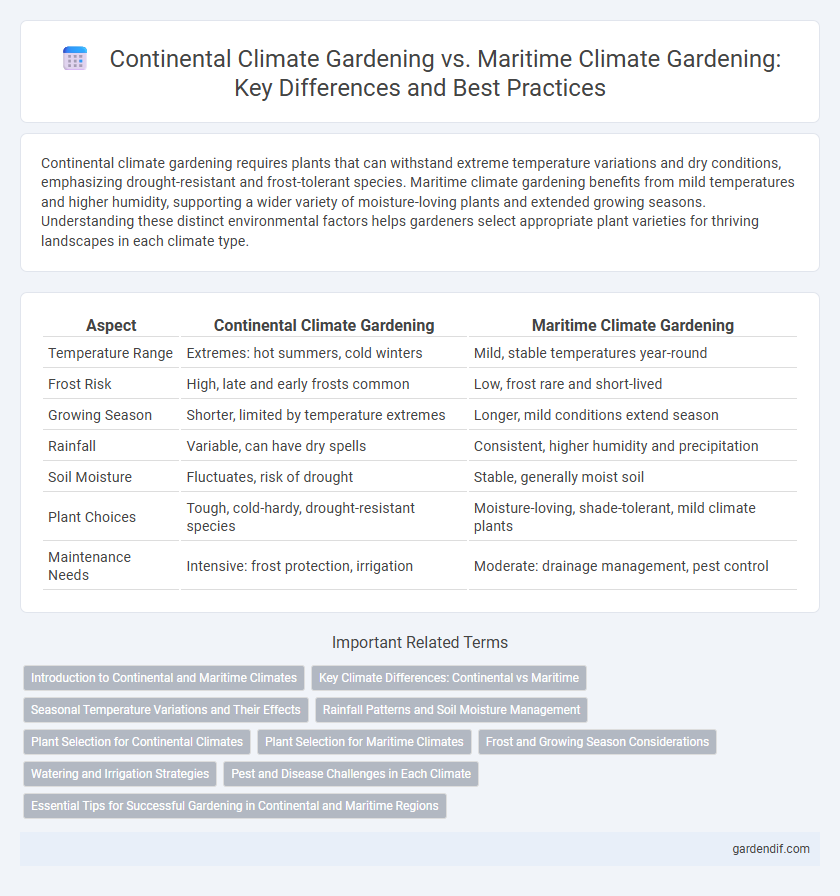
Continental climate gardening vs Maritime climate gardening Illustration
Continental climate gardening requires plants that can withstand extreme temperature variations and dry conditions, emphasizing drought-resistant and frost-tolerant species. Maritime climate gardening benefits from mild temperatures and higher humidity, supporting a wider variety of moisture-loving plants and extended growing seasons. Understanding these distinct environmental factors helps gardeners select appropriate plant varieties for thriving landscapes in each climate type.
Table of Comparison
| Aspect | Continental Climate Gardening | Maritime Climate Gardening |
|---|---|---|
| Temperature Range | Extremes: hot summers, cold winters | Mild, stable temperatures year-round |
| Frost Risk | High, late and early frosts common | Low, frost rare and short-lived |
| Growing Season | Shorter, limited by temperature extremes | Longer, mild conditions extend season |
| Rainfall | Variable, can have dry spells | Consistent, higher humidity and precipitation |
| Soil Moisture | Fluctuates, risk of drought | Stable, generally moist soil |
| Plant Choices | Tough, cold-hardy, drought-resistant species | Moisture-loving, shade-tolerant, mild climate plants |
| Maintenance Needs | Intensive: frost protection, irrigation | Moderate: drainage management, pest control |
Introduction to Continental and Maritime Climates
Continental climates feature significant temperature variations between seasons, characterized by hot summers and cold winters, impacting plant selection and garden maintenance with a need for frost-resistant and drought-tolerant species. Maritime climates, influenced by proximity to large bodies of water, exhibit mild temperatures and high humidity, promoting a longer growing season and favoring moisture-loving plants and evergreen varieties. Understanding these climatic differences is crucial for optimizing plant health, soil management, and irrigation strategies in gardening practices.
Key Climate Differences: Continental vs Maritime
Continental climate gardening faces greater temperature extremes with hot summers and cold winters, requiring plants to withstand freeze-thaw cycles and drought conditions. Maritime climate gardening benefits from moderate temperatures, high humidity, and consistent rainfall, creating stable growing environments with less frost risk. Gardeners in continental regions prioritize drought-resistant and cold-hardy species, while maritime gardeners emphasize tolerance to moisture and mild temperature variations.
Seasonal Temperature Variations and Their Effects
Continental climate gardening experiences extreme seasonal temperature variations, with hot summers and cold winters that impact plant growth cycles by causing shorter growing seasons and requiring frost-resistant species. Maritime climate gardening benefits from mild temperature fluctuations due to oceanic influence, promoting longer growing periods and supporting a wider variety of temperature-sensitive plants. These differences in seasonal temperature stability directly affect soil conditions, plant phenology, and the selection of appropriate horticultural practices.
Rainfall Patterns and Soil Moisture Management
Continental climate gardening experiences significant rainfall variability with periods of drought followed by heavy rains, necessitating efficient soil moisture management through mulching and deep watering techniques to retain moisture and prevent erosion. In contrast, maritime climate gardening benefits from consistent, moderate rainfall that maintains steady soil moisture levels, reducing the need for frequent irrigation but requiring well-draining soil to avoid waterlogging. Understanding these distinct rainfall patterns and soil moisture dynamics is crucial for selecting appropriate plant species and optimizing garden health in each climate type.
Plant Selection for Continental Climates
Plants suited for continental climates must tolerate significant temperature fluctuations and seasonal extremes, such as cold winters and hot summers. Hardy perennials like coneflowers, daylilies, and hostas thrive in these conditions by adapting to brief growing seasons and periodic droughts. Incorporating native species such as prairie grasses and deciduous shrubs enhances resilience and supports local biodiversity in continental climate gardens.
Plant Selection for Maritime Climates
Maritime climate gardening requires selecting plants that thrive in mild, humid conditions with minimal temperature extremes and consistent moisture, favoring species like hydrangeas, camellias, and ferns. Hardy shrubs and perennials adapted to salty winds and damp soils, such as sea thrift and coastal sage, perform well in these environments. Choosing plants with high tolerance for moisture and less drought resistance is essential for successful growth in maritime climates.
Frost and Growing Season Considerations
Continental climate gardening experiences more severe frost events and a shorter growing season due to greater temperature extremes, necessitating frost-resistant plant selections and protective measures. Maritime climate gardening benefits from milder winters with fewer frost occurrences and a longer growing season, allowing for a wider variety of plants and extended cultivation periods. Gardeners in continental zones must prioritize frost dates and hardiness zones, while maritime gardeners can exploit the extended growing window for diverse planting schedules.
Watering and Irrigation Strategies
Continental climate gardening requires frequent and deep watering to combat hot, dry summers and cold winters that limit soil moisture retention, emphasizing irrigation systems that conserve water such as drip irrigation or soaker hoses. Maritime climate gardening benefits from consistent rainfall and milder temperatures, allowing gardeners to rely less on supplemental watering but focus on well-drained soils to prevent waterlogging. Efficient irrigation scheduling tailored to temperature fluctuations and precipitation patterns in each climate type optimizes plant health and conserves water resources.
Pest and Disease Challenges in Each Climate
Continental climate gardening faces increased pest and disease challenges due to extreme temperature fluctuations and dry conditions that favor pests like aphids and fungal diseases such as powdery mildew. Maritime climate gardening benefits from moderate temperatures and higher humidity, promoting a diverse but persistent range of pests including slugs and fungal infections like leaf spot. Effective pest management in continental climates requires drought-resistant and pest-tolerant plants, while maritime climate gardening emphasizes vigilant disease monitoring and moisture control to prevent fungal outbreaks.
Essential Tips for Successful Gardening in Continental and Maritime Regions
Gardening in continental climates requires selecting drought-resistant and cold-hardy plants to withstand temperature extremes and seasonal fluctuations. Maritime climate gardening benefits from moisture-loving and salt-tolerant species due to mild winters, moderate summers, and high humidity. Proper soil preparation, mulching, and adaptive watering strategies tailored to each climate's unique conditions ensure plant health and maximize garden productivity.
Continental climate gardening vs Maritime climate gardening Infographic

 gardendif.com
gardendif.com